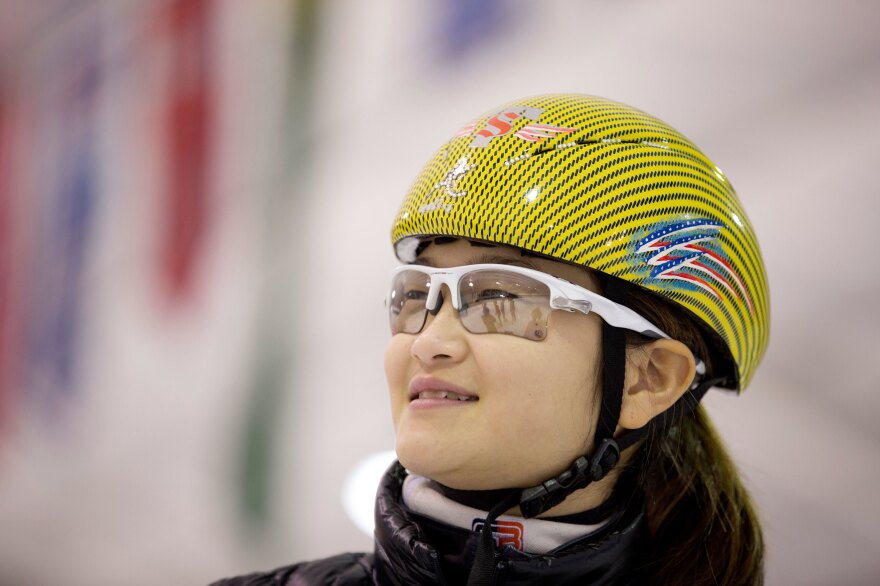It's 6 a.m. and 14-year-old Kyubin Oh is wrapping up her first short track speedskating practice of the day. She unlaces her hot-pink skates. "The training's really hard," she says. "I do have my dream goal, which is obviously the Olympics." Then she giggles and cracks a huge smile.

Five days a week, Monday to Friday, Kyubin gets up at 3:30 a.m. and heads to the ice rink to practice with her skating clubmates from Dominion Speedskating in Reston, Virginia, about 20 miles outside Washington, D.C. She trains for an hour-and-a-half with a coach and about a dozen other kids, then heads home for a quick nap before school. After school and on Saturdays, the club meets for another two hours of strength training off the ice.

Short-track speedskating, which made its Olympic debut at the 1992 Winter Games, has become hugely popular in South Korea, China and Japan. Four to six skaters race around an 111-meter oval track for 500, 1,000, or 1,500 meters — or longer, for relays. They guide themselves around the curves by placing their fingertips on the ice, and use positioning to out-maneuver other skaters. The tight grouping of skaters can lead to dramatic finishes and colossal wipeouts.
In the U.S., the popularity of this sport is dwarfed by the dominant ice sports of figure skating and hockey. Many Americans have only heard of speedskating in the context of its biggest U.S. star, eight-time Olympic medalist Apolo Anton Ohno — if they have heard of it at all.
But around the nation's capital, a handful of small skating clubs have been quietly churning out world-class skaters for the past decade. This year, 9 of 32 short track speedskaters who competed in the Olympic trials came from the Washington, D.C. region. Two of the eight athletes who ended up making the U.S. Olympic speedskating team are from the D.C. suburbs — Thomas Hong of Laurel, Md., and Maame Biney of Reston, Va.

Biney, who trained with Dominion Speedskating, is the first African-American woman to qualify for a U.S. Olympic speedskating team.

According to Ted Morris, the executive director of U.S. Speedskating, skaters from the D.C. area excel because of their technical skills.
Speed is, of course, a key element of short track racing: Olympic skaters can reach velocities of up to 30 miles per hour. But, Morris says, the most adept athletes combine fast skating with the ability to maneuver past the competition during races and use smooth crossover footwork to propel themselves around the rink's curves.
The key to building those technical skills? Great coaching. A little over a decade ago, the elite speedskating clubs in the D.C. region began to employ coaches from South Korea. Club parents, many of whom are South Korean immigrants, take it upon themselves to recruit the coaches, help them secure travel visas and pay their salaries. Each of the elite clubs in the D.C. area, including Dominion Speedskating, typically employs one to two Korean coaches at a time.

Because speedskating remains relatively unknown in the U.S., with only 1,100 registered athletes (in comparison, there are some 200,000 registered figure skaters), most American clubs don't have high enough members to pay for professional coaches. They rely on volunteer coaches. But the high-level Korean coaches' expertise gives D.C.-area skaters an advantage in American competition.

Having Korean coaches is "the No. 1 factor why [the Washington area] has become such a hotbed" for speedskating, says Nathaniel Mills, a three-time long-track Olympian who founded the DC Inner City Excellence (ICE) urban speedskating program in Washington's Anacostia neighborhood. "The intense practices, the daily drills, the off-ice training: they instilled that in these clubs."
Speedskating is also expensive, and the Washington suburbs include some of the wealthiest areas in the country. Club parents in the D.C. region say they spend more than $10,000 every year on ice time, coaching and travel to out-of-state races. Many parents originally from South Korea even send their kids to train in South Korea during the summer.

"You have a lot of type-A parents in the D.C. area," Morris said.
At Kyubin Oh's morning practice, her father Eddie Oh clutches a coffee mug and groggily watches his daughter skate. "It's time-consuming for parents. We have to give up everything," he says with a tired laugh. "But you know they're having fun."
Family life revolves around Kyubin's practice regimen, which leaves little or no time for socializing outside the club circle. Vacation time is devoted to more practice or out-of-state meets.
For Kyubin, it's all about reaching her goal of competing at the Beijing Olympics in 2022 — following in the footsteps of her role model and former Dominion Speedskating clubmate Maame Biney.
"I just want to keep skating until I feel like all of my practice was worth it," she says, "and I actually did something in my life." Then she giggles and zips up her puffy coat to head to her dad's car.
Outside, the sun is just starting to rise.
Copyright 2021 WAMU 88.5. To see more, visit WAMU 88.5. 9(MDAyMTYyMzM0MDEyOTc4NzE4ODM3ZDEwYQ001))


